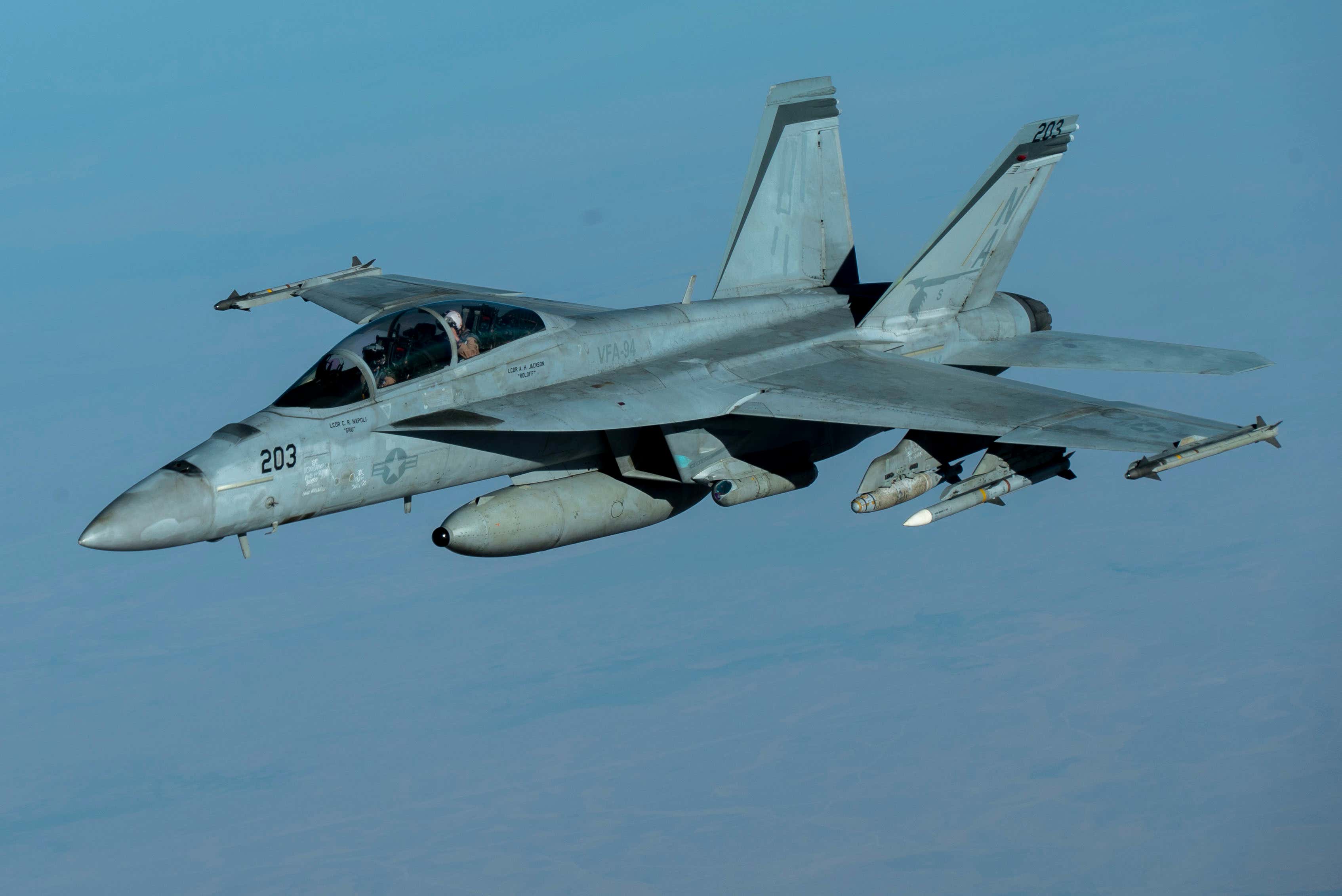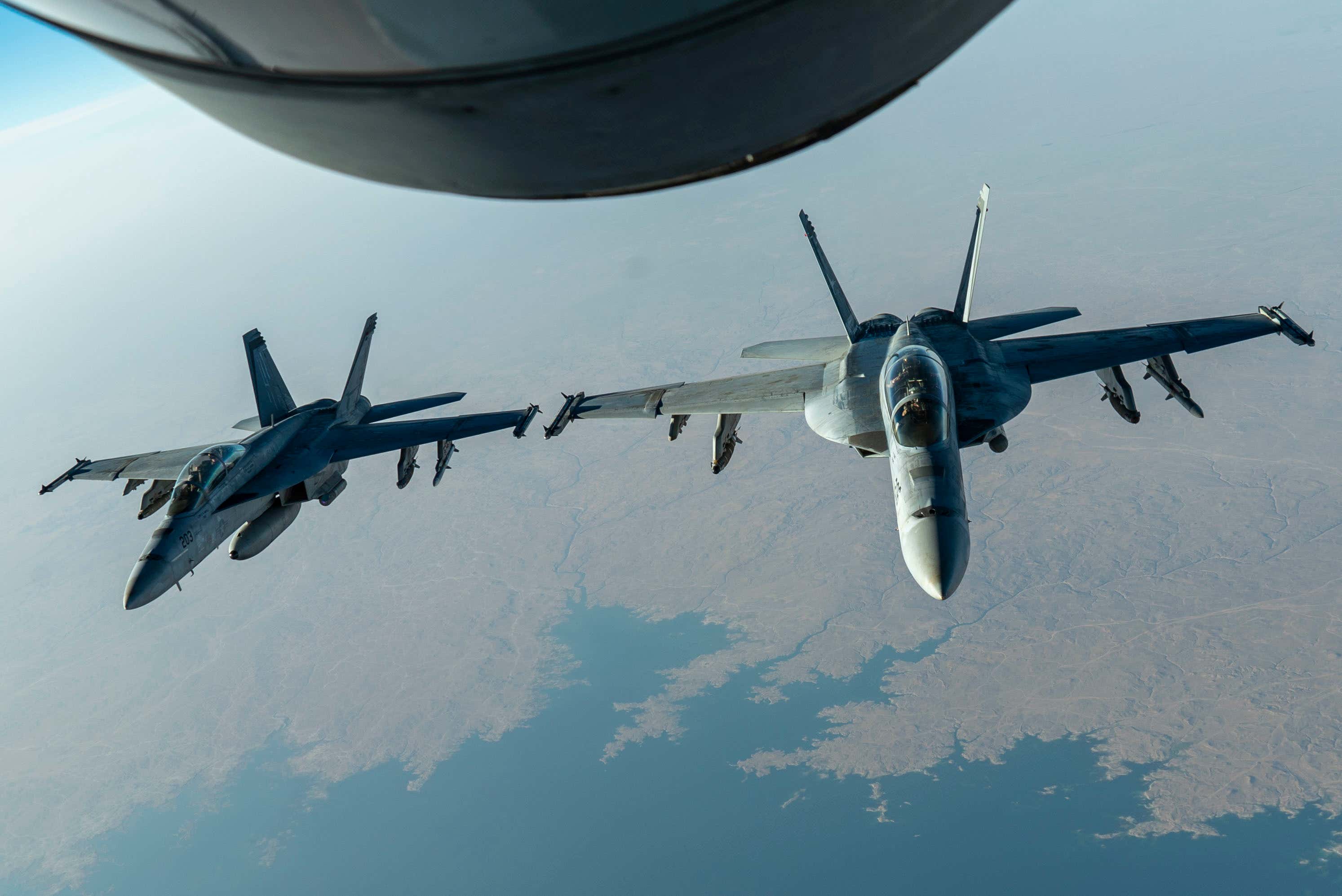The F/A-18F flew a sortie over the Middle East carrying the pod, which isn't scheduled to be operational until late 2021.

The Super Hornet is set to officially receive one of its biggest sensor upgrades ever next year with the addition of an infrared search and track pod. The system, which is integrated into the Super Hornet's centerline fuel tank, will give the jet the ability to detect and engage low-observable (stealthy) and small radar cross-section targets at well beyond visual range, along with a slew of other capabilities. You can read all about the sensor and the Navy's plans for it in more detail than anywhere else in this past War Zone interview with the head of the Navy's Super Hornet program. Now, that system has appeared on deployment for the first time, over the tumultuous skies of the Middle East, a year before it is supposed to be operational.
The images below were posted by the Department of Defense. They show a pair of F/A-18F Super Hornets from VFA-94 "Mighty Strikes" flying over Central Command's area of responsibility "in support of Operation Inherent Resolve." The "Mighty Strikes" are attached to Carrier Air Wing 17, which is deployed aboard the USS Nimitz (CVN 68), which is presently plowing the waters of the Persian Gulf.
The jets are armed with live AIM-120 AMRAAM and AIM-9X Sidewinder air-to-air missiles, ATFLIR targeting pods, and GBU-38/B JDAMs and GBU-54/B Laser JDAMs. As such, it is interesting to note that the IRST pod is being flown on these combat missions.


It isn't clear what version of the Navy's IRST pod we are seeing. The earlier Block I iteration of the system has been in testing for some time. It is likely that this is the version of the system shown in these photos. It would make some sense to deploy the earlier version of the pod on an operational cruise to better understand how the final production version will slot into the Air Wing when it comes online in about one year's time. It would also give the Air Wing a capability it currently lacks, providing another tool to spot targets that are very hard to detect on radar, and an air-to-air sensor system that is not impacted by electronic warfare at all. Both attributes would be highly beneficial considering Iran is very active when it comes to both of these warfighting capabilities. In particular, the country's rapid development and successful use of hard-to-detect low-flying cruise missiles and drones pose a major threat to American and allied assets in the region. Just ask Saudi Arabia.
It's also worth mentioning that Nimitz got its own set of new long-range infrared 'eyes' for this deployment. That sensor, which you can read more about here, is more for general surveillance and target identification, not for detecting and engaging enemy aircraft over long distances.
Regardless, the Super Hornet's IRST has officially hit the fleet, even in a limited operational test basis. It will be highly interesting to learn more about its deployment. We have already reached out to the Navy for more info on this historic deployment.

 www.thedrive.com
www.thedrive.com
The Super Hornet is set to officially receive one of its biggest sensor upgrades ever next year with the addition of an infrared search and track pod. The system, which is integrated into the Super Hornet's centerline fuel tank, will give the jet the ability to detect and engage low-observable (stealthy) and small radar cross-section targets at well beyond visual range, along with a slew of other capabilities. You can read all about the sensor and the Navy's plans for it in more detail than anywhere else in this past War Zone interview with the head of the Navy's Super Hornet program. Now, that system has appeared on deployment for the first time, over the tumultuous skies of the Middle East, a year before it is supposed to be operational.
The images below were posted by the Department of Defense. They show a pair of F/A-18F Super Hornets from VFA-94 "Mighty Strikes" flying over Central Command's area of responsibility "in support of Operation Inherent Resolve." The "Mighty Strikes" are attached to Carrier Air Wing 17, which is deployed aboard the USS Nimitz (CVN 68), which is presently plowing the waters of the Persian Gulf.
The jets are armed with live AIM-120 AMRAAM and AIM-9X Sidewinder air-to-air missiles, ATFLIR targeting pods, and GBU-38/B JDAMs and GBU-54/B Laser JDAMs. As such, it is interesting to note that the IRST pod is being flown on these combat missions.


It isn't clear what version of the Navy's IRST pod we are seeing. The earlier Block I iteration of the system has been in testing for some time. It is likely that this is the version of the system shown in these photos. It would make some sense to deploy the earlier version of the pod on an operational cruise to better understand how the final production version will slot into the Air Wing when it comes online in about one year's time. It would also give the Air Wing a capability it currently lacks, providing another tool to spot targets that are very hard to detect on radar, and an air-to-air sensor system that is not impacted by electronic warfare at all. Both attributes would be highly beneficial considering Iran is very active when it comes to both of these warfighting capabilities. In particular, the country's rapid development and successful use of hard-to-detect low-flying cruise missiles and drones pose a major threat to American and allied assets in the region. Just ask Saudi Arabia.
It's also worth mentioning that Nimitz got its own set of new long-range infrared 'eyes' for this deployment. That sensor, which you can read more about here, is more for general surveillance and target identification, not for detecting and engaging enemy aircraft over long distances.
Regardless, the Super Hornet's IRST has officially hit the fleet, even in a limited operational test basis. It will be highly interesting to learn more about its deployment. We have already reached out to the Navy for more info on this historic deployment.

F/A-18 Super Hornets Are Flying Middle East Combat Missions With New Infrared Sensor Pod
The F/A-18F flew a sortie over the Middle East carrying the pod, which isn't scheduled to be operational until late 2021.


